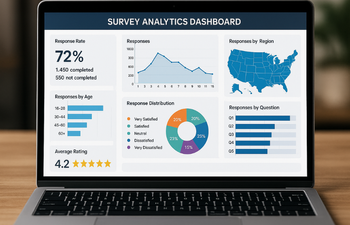Incentives in Surveys: What Works and What Backfires
Discover how incentives in surveys can drive participation or derail data quality. Learn what motivates and what backfires.

Introduction
Surveys are critical tools in market research, social science, and user experience. Yet, their success heavily depends on the willingness of participants to engage. This is where incentives come into play. But incentives are a double-edged sword: while they can boost participation rates, they can also introduce bias, reduce data quality, or even repel potential respondents if not handled correctly.
The Psychology Behind Survey Incentives
Understanding why people respond to incentives starts with behavioral economics. Human motivation is driven not just by monetary gains but also by recognition, reciprocity, and personal interest. When designing survey incentives, tapping into intrinsic and extrinsic motivators is key.
Types of Survey Incentives That Work
Effective incentives vary depending on the target audience, survey length, and context. Here are several that consistently perform well:
- Cash payments or digital wallets (e.g., PayPal, Venmo)
- Gift cards (Amazon, Starbucks, etc.)
- Discounts or coupons for future purchases
- Loyalty points for members or customers
- Access to exclusive data or content
Each of these incentives carries a specific appeal. Cash offers are universal, while brand-specific rewards resonate better with loyal customers.
The Trade-off Between Participation and Data Quality
While incentives often increase response rates, there's a catch. High incentives can skew the respondent pool, attracting individuals who may not represent the target demographic. Worse, they may lead to satisficing, where participants rush through surveys just to get the reward.
For actionable strategies to increase participation without sacrificing data quality, see How to Boost Your Survey Response Rate: 7 Proven Tips.
Monetary Incentives: The Good, The Bad, and The Ugly
Money talks, but sometimes, it says the wrong thing. When using cash or gift cards:
- Keep the amount reasonable to avoid attracting disingenuous respondents.
- Clearly define eligibility to prevent abuse.
- Use tiered rewards for longer surveys to maintain engagement.
Overly generous monetary incentives may backfire by undermining the authenticity of the data collected.
Non-Monetary Incentives: An Underused Strategy
Not every incentive must involve cash. In some contexts, recognition or gamification works just as well.
- Badges or points in an app ecosystem
- Access to survey results or benchmarking data
- Personalized feedback or assessments
- Entry into a professional or industry leaderboard
These methods work particularly well in academic, professional, or enthusiast communities.
Cultural Considerations in Survey Incentives
What works in one culture may flop in another. For example, in collectivist societies, altruistic motivations or community contributions might be more appealing than individual rewards. It's crucial to localize incentive strategies for global audiences.
Ethical Considerations When Offering Incentives
Survey incentives must be ethical and not coercive. Over-incentivizing vulnerable groups (like low-income populations) can exploit economic needs. Transparency about what participants can expect is essential for maintaining trust and integrity.
Survey Incentives and GDPR/CCPA Compliance
Incentivizing surveys that collect personal data must align with data protection laws. Always:
- Disclose data collection purposes.
- Obtain informed consent.
- Allow opt-outs without penalty.
Neglecting these aspects can lead to legal consequences.
Incentives in B2B Surveys
B2B audiences require a different approach. Time is their most valuable asset, so consider offering:
- Charitable donations in their name
- Industry reports or whitepapers
- Exclusive networking invitations
- Discounted services or tools
B2B professionals appreciate incentives that offer long-term value.
Gamification as an Incentive
Making surveys fun can be an incentive in itself. Gamification techniques include:
- Interactive quizzes
- Progress bars and levels
- Time-based challenges
- Real-time feedback
These techniques increase both completion rates and respondent satisfaction.
Incentive Timing: Before or After the Survey?
Timing is everything. Prepaid incentives (given before the survey) tend to improve completion rates and demonstrate goodwill, while promised incentives (after completion) ensure only those who complete the survey receive rewards. Each method has pros and cons depending on context.
Do Sweepstakes Work?
Sweepstakes or prize draws are cost-effective but can be a gamble. Their success depends on perceived fairness and the attractiveness of the prize. Ensure clear rules and avoid overly complex entry requirements.
Segmenting Your Audience for Targeted Incentives
One size doesn’t fit all. By segmenting audiences (e.g., by age, occupation, or geography), you can tailor incentives that resonate more deeply with each group. For example:
When Incentives Backfire
Backfires occur when:
- Incentives are too large and feel suspicious.
- Participants game the system (e.g., bots or duplicate entries).
- The survey topic doesn't justify the reward.
- Incentives cause distractions or unintended focus.
Understanding these pitfalls helps prevent costly mistakes.
Testing and Optimization of Incentives
Before rolling out incentives at scale, test them in smaller samples. Use A/B testing to compare effectiveness and refine strategies. Monitor dropout rates, completion times, and data quality metrics to find the sweet spot.
Transparency in Incentive Communication
Always be transparent about:
- What the incentive is
- When and how it will be delivered
- Any eligibility requirements
Lack of clarity can erode trust and reduce future participation.
Long-Term Effects of Incentivizing Surveys
Over time, incentives may create a culture of expectation. Participants might begin to expect rewards for every survey, which isn’t sustainable. Mix incentivized and non-incentivized surveys to strike a balance.
To better understand what your response rate really means and how to improve it, check out What a 30% Survey Response Rate Really Means (and How to Improve It).
Building Loyalty Through Thoughtful Incentives
When done right, incentives can build brand loyalty. Reward systems tied to surveys (e.g., points added to customer accounts) can enhance engagement and satisfaction.
How Survey Mode Affects Incentive Type
Online, phone, and in-person surveys each benefit from different incentive strategies. For example:
Balancing Budget Constraints
For organizations with limited budgets, focus on perceived value rather than actual cost. A thoughtful thank-you note or exclusive access to insights can outperform small cash incentives in perceived worth.
Leveraging Technology for Better Incentive Distribution
Modern platforms offer seamless integration of incentives:
- Automated digital gift card distribution
- Real-time sweepstakes entries
- Dynamic incentive assignment based on respondent profile
These tools reduce administrative burden and improve user experience.
Final Thoughts on Incentives in Surveys
Designing the right incentive strategy requires empathy, testing, and alignment with your survey’s goals. While there’s no universal answer, keeping the respondent's perspective front and center can dramatically improve both participation and data quality.
Frequently Asked Questions
Find answers to the most common questions about this topic
Common types include cash rewards, gift cards, discounts, loyalty points, and entries into sweepstakes.
Not always. While they can increase participation, poorly chosen incentives can reduce data quality or attract biased responses.
Yes, overly generous incentives may attract participants who are only interested in the reward, compromising data integrity.
Incentives might lead to satisficing or rushed responses if participants are more interested in the reward than the content.
Recognition, feedback, and access to exclusive content are effective non-monetary motivators for many demographics.
Cultural norms and expectations play a big role; what works in one region or group might not be effective in another.









